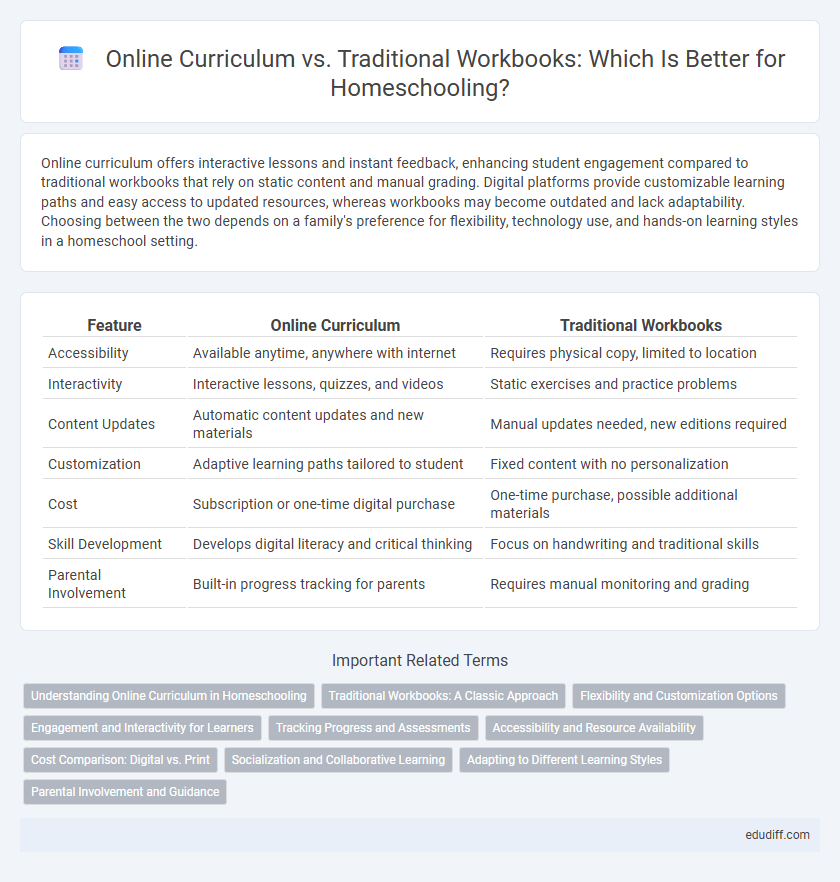Online curriculum offers interactive lessons and instant feedback, enhancing student engagement compared to traditional workbooks that rely on static content and manual grading. Digital platforms provide customizable learning paths and easy access to updated resources, whereas workbooks may become outdated and lack adaptability. Choosing between the two depends on a family's preference for flexibility, technology use, and hands-on learning styles in a homeschool setting.
Table of Comparison
| Feature | Online Curriculum | Traditional Workbooks |
|---|---|---|
| Accessibility | Available anytime, anywhere with internet | Requires physical copy, limited to location |
| Interactivity | Interactive lessons, quizzes, and videos | Static exercises and practice problems |
| Content Updates | Automatic content updates and new materials | Manual updates needed, new editions required |
| Customization | Adaptive learning paths tailored to student | Fixed content with no personalization |
| Cost | Subscription or one-time digital purchase | One-time purchase, possible additional materials |
| Skill Development | Develops digital literacy and critical thinking | Focus on handwriting and traditional skills |
| Parental Involvement | Built-in progress tracking for parents | Requires manual monitoring and grading |
Understanding Online Curriculum in Homeschooling
Online curriculum in homeschooling offers interactive lessons, multimedia resources, and adaptive learning paths that cater to individual student needs, enhancing engagement and retention. Unlike traditional workbooks, which provide static content and require self-motivation, online platforms often include real-time assessments and feedback, enabling parents to monitor progress effectively. This dynamic approach supports diverse learning styles and fosters independent study skills critical for academic success in a homeschool environment.
Traditional Workbooks: A Classic Approach
Traditional workbooks offer a tactile and structured learning experience that fosters consistent practice and mastery of core subjects. Utilizing printed pages encourages focus and minimizes digital distractions, making it ideal for young learners developing foundational skills. Their portability and simplicity provide flexibility for homeschooling families without reliance on technology or internet access.
Flexibility and Customization Options
Online curriculum offers greater flexibility by allowing parents and students to adjust lessons and pacing according to individual learning needs, unlike traditional workbooks that follow a fixed structure. Customization options in digital platforms enable the integration of multimedia resources and interactive assessments, enhancing engagement and adaptability. Traditional workbooks provide a tactile learning experience but lack the dynamic adjustment capabilities found in online programs.
Engagement and Interactivity for Learners
Online curriculum offers interactive features such as multimedia lessons, quizzes, and immediate feedback, significantly boosting learner engagement compared to traditional workbooks. Digital platforms adapt to individual learning speeds and styles, providing personalized experiences that keep students motivated. Traditional workbooks, while effective for practice, lack dynamic elements that foster active participation and real-time understanding.
Tracking Progress and Assessments
Online curriculum platforms offer dynamic tracking tools with real-time progress monitoring and automated assessments, enabling personalized learning experiences tailored to student needs. Traditional workbooks rely on manual grading and periodic evaluations, making it challenging to maintain consistent progress records and timely feedback. Digital assessment analytics provide detailed insights into student performance trends, which are less accessible with conventional workbook methods.
Accessibility and Resource Availability
Online curriculum offers unparalleled accessibility by providing instant access to a vast array of interactive lessons, multimedia resources, and up-to-date content from any device with internet connectivity. Traditional workbooks, while tangible and familiar, often limit learners to static pages and require physical storage space, restricting availability to the materials on hand. Digital platforms continuously update and expand their resource libraries, enabling homeschool families to tailor education dynamically and access specialized subjects without geographic constraints.
Cost Comparison: Digital vs. Print
Online curriculum often offers a more cost-effective solution compared to traditional workbooks by reducing expenses related to printing, shipping, and physical storage. Digital programs typically provide subscription models or one-time purchases with access to continuously updated content, eliminating the need for frequent workbook replacements. While initial technology investment may be higher, the overall long-term savings favor online curricula due to enhanced scalability and resource versatility.
Socialization and Collaborative Learning
Online curriculum platforms often incorporate interactive tools and virtual group projects that enhance socialization and collaborative learning among homeschool students. Traditional workbooks typically lack opportunities for peer interaction, making it harder to develop social skills and teamwork experience. Integrating digital resources with in-person group activities can balance the structured learning of workbooks and the dynamic engagement of online programs.
Adapting to Different Learning Styles
Online curriculum offers dynamic multimedia resources and interactive lessons that adapt to visual, auditory, and kinesthetic learning styles, enhancing student engagement. Traditional workbooks rely on repetitive exercises and written tasks, which may suit learners who excel in independent, self-paced study but can limit adaptability for diverse learning preferences. Blending online tools with workbook activities provides a balanced approach that supports personalized learning pathways and improves comprehension.
Parental Involvement and Guidance
Online curriculum offers interactive lessons and instant feedback, enhancing parental involvement through real-time monitoring and tailored support. Traditional workbooks require parents to actively guide learning, ensuring comprehension and fostering discipline through hands-on engagement. Both methods benefit from parental support, but digital tools provide more data-driven insights to customize education effectively.
Online Curriculum vs Traditional Workbooks Infographic

 edudiff.com
edudiff.com